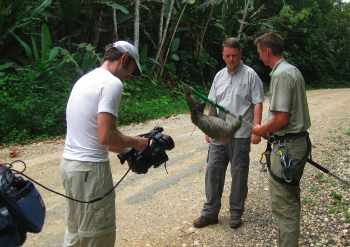A doctoral student with the Max Planck Institute, Bryson Voirin studies sloths and other species at the Smithsonian Tropical Research Institute. Mongabay.com’s sixth in a series of interviews with ‘Young Scientists’.
Sloths sleep all day; they are always slow; and they are gentle as lambs. These are just some of the popular misconceptions that sloth-scientist and expert tree-climber, Bryson Voirin, is overturning.
After growing up among the wild creatures of Florida, spending his high school years in Germany, and earning a Bachelors degree in biology and environment at the New College of Florida, Voirin found his calling.
At the New College of Florida, Voirin “met Meg Lowman, the famous canopy pioneer who invented many of the tree climbing techniques everyone uses today. After the first day lecture, I realized that this was someone who was doing exactly what I wanted to do. I walked up after class to talk with her and ended up heading down to Panama a few months later with her to help on the set of the JASON Project. With my climbing and science background, it worked out perfectly. Canopy science was it.”
|
|
Climbing tall trees in the tropics led Voirin to consider studying arboreal mammals. Although his first thought was to focus on arboreal cats with advice from a professor he decided to start with sloths.
“Sloths are unique in that they are the slowest mammals on Earth,” Voirin told Mongabay.com. “It’s funny saying that, because often times I am out-run by them in the trees while I am trying to catch them. Sloths are a real classic example of niche behavior. Almost everything about them is specially geared towards their slow, arboreal lifestyle. They have green, algae rigged fur they disguises them as foilage. Their nerves are evolved to react slower, so they do not flinch or react to noises. These animals are true specialists.”
The first step for Voirin and fellow researchers was to catch and tag sloths, however despite their biological slowness and their cute exterior, the researchers soon discovered that catching a sloth was a learning experience in itself.
“They are incredibly difficult to even find. I think it took 3 weeks to find and catch my first one. After that, I got better and improvised techniques to catch them. But it is still a huge challenge each time,” Voirin says. “In photos they look a lot like a teddy bear, but in reality they have sharp claws that can do some serious damage. They can move quick when they want to, and they are not defenseless. People always laugh when I tell them I have scars all over my arms from sloths, but it’s true. They can definitely hurt you.”
 One of Voirin’s subjects, the sloth. Photo courtesy of Bryson Voirin. |
For a long time, scientists thought that sloths spent nearly their entire lives asleep. This was based on studies of sloths in captivity, where the animals, in fact, slept 18-20 hours a day. However Voirin and fellow researchers overturned this assumption by conducting the first sleep study of sloths in the wild.
“We have shown that in the wild, they sleep around 9 hours—a whole lot less. This may be due to animals being bored in captivity, increased predation risk in the wild, the need to find forage, or one of many other variables. By doing the research in the wild, we have shown sloths are not actually as sleepy as we previously thought,” he says.
Since all sleep studies of animals—prior to this—were conducted in captivity, Voirin says that their study’s findings should cause researchers to rethink the sleep patterns of other animals in the wild. If sloths sleep twice as much in captivity as in the wild, it’s quite possible other species do the same.
“That’s the beauty of science,” Voirin says. “We are always learning new things.”
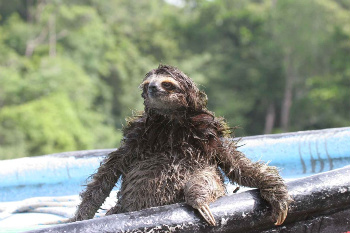 Sloth in a boat. Photo courtesy of Bryson Voirin. |
There are six species of sloth in the world, and although four of them are considered Least Concern by the IUCN Red List, sloth’s are not immune to the many threats facing tropical species.
“Maned three-toed sloths and pygmy three-toed sloths are both critically endangered,” Voirin explains. “Both of these species are threatened by habitat destruction. The maned sloths live in the coastal rainforest of Brazil, and the pygmy sloths are only found on one island off the coast of Panama. I have worked quite a lot on the pygmy sloths on the island of Escudo de Veraguas, and there are certainly not too many of them in existence. It’s thought that the total population is less than 100 sloths.”
Voirin believes that education and knowledge are the best ways to save sloths and other species. He says that the most important thing scientists can do is share their discoveries with the world.
“I enjoy writing pop articles for newspapers or magazines read by people of all ages and backgrounds. Or giving talks to school children about the rainforest, or sloths, or any exciting research I am working on. I think it is my duty to connect with the general public in these ways, and share knowledge,” Voirin says.
In an October 2009 interview Mongabay spoke with Bryson Voirin about the ecology and behavior of sloths, the science of tree-climbing, tracking tropical species like dragonflies and oilbirds, and the importance of sharing the beauty of the tropics with the public.
PERSONAL
Mongabay: How did you become interested in wildlife? What is your background?
Bryson Voirin: I feel like I have always been fascinated by the natural world. I remember being in elementary school, watching some National Geographic special, and saying to myself, “That is exactly what I want to do.” And now here I am, living my dream, traveling around the world studying some of the coolest animals. All of my favorite books growing up were wildlife encyclopedias, bird guides, nature companions, and world atlases. My friends in grade school used to joke with me and call me “Encyclopedia Brysonia,” because I was always rattling off random facts about some animals or rainforest creature. I was always catching some snake or lizard in my back yard, and my parents were always yelling at me to put it down. Growing up in Florida, I was always outside up in a tree or in the middle of a swamp. It was great.
I went to high school abroad in Germany. I lived in Kiel and Berlin, two very different cities with very different landscapes. I got really into mountain biking and rock climbing over there, and loved to explore the various new ecosystems I had never encountered before. I started climbing pretty regularly after that, and really got into anything above the ground. Buildings, rock, trees, it didn’t matter, I wanted to climb it.
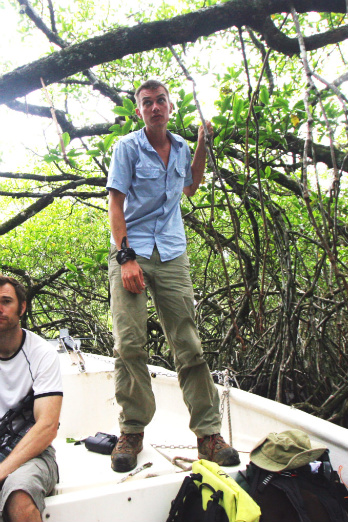 Working in the field. Photo courtesy of Bryson Voirin. |
For my university studies, I moved back to Florida and attended New College of Florida. The great thing about going there was the academic freedom they gave me to pursue my research interests. I earned a double Bachlor’s degree, one in Biology and one in Environmental Studies. It was there I met Meg Lowman, the famous canopy pioneer who invented many of the tree climbing techniques everyone uses today. After the first day lecture, I realized that this was someone who was doing exactly what I wanted to do. I walked up after class to talk with her and ended up heading down to Panama a few months later with her to help on the set of the JASON Project. With my climbing and science background, it worked out perfectly. Canopy science was it.
The rainforest was almost an obsession as a kid. I knew every bird that lived in the Amazon, every cat and monkey, and what they all ate. I also knew there were some of the tallest trees in the world there. After visiting the forest time in Panama and climbing a huge Cebia tree, I was hooked. There was no where else I wanted to work. The forest there is inspiring and life changing. Spend a few weeks there climbing one of the canopy giants, and your life will never be the same. There is this primal feeling there, like you are back in time, before humans. It is truly amazing.
Because of New College’s flexibility in their academic structure, they allowed (and even funded) me to return numerous times to Panama to conduct various research projects. I really wanted to work with arboreal mammals, and sloths were a great one to start with. We thought it would be an easy one, but in actuality they are incredibly difficult to even find. I think it took 3 weeks to find and catch my first one. After that, I got better and improvised techniques to catch them. But it is still a huge challenge each time.
Right now, I continue to work with the Smithsonian Tropical Research Institute, and am currently working on my PhD through the Max Planck Institute. Both of these institutes are incredible, from the staff to the facilities to the research coming out of there. The people working at both are some of the smartest and most interesting I have ever met. Just having dinner with one person from either institute can yield 50 new research questions you could spend a lifetime investigating. These two institutes are really unparalleled.
STUDYING SLOTHS
Mongabay: What drew you to studying sloths? What makes sloths unique in the animal kingdom?
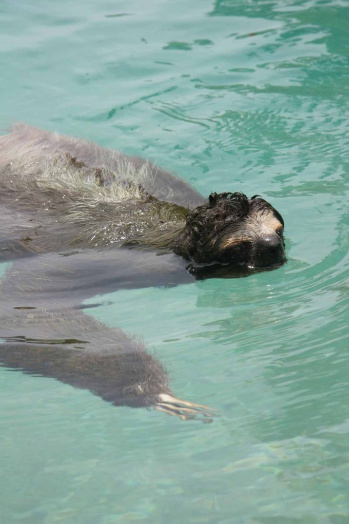 Sloths are surprisingly adept swimmers. Photo courtesy of Bryson Voirin. |
Bryson Voirin: I stared studying sloths as an undergraduate. As I was completely infatuated by tree climbing, I wanted to study some sort of arboreal mammal. Sloths seemed a prefect fit, as they were both arboreal and an animal that I could feasibly catch. I had originally imagined working with canopy cats, but to date no one has been able to successfully catch and radio collar them on a regular basis. My project sponsor Roland Kays of the New York State Museum suggested the sloth as a starting point, and since then they have really stuck with me. Sloths are unique in that they are the slowest mammals on Earth. It’s funny saying that, because often times I am out-run by them in the trees while I am trying to catch them. Sloths are a real classic example of niche behavior. Almost everything about them is specially geared towards their slow, arboreal lifestyle. They have green, algae rigged fur they disguises them as foilage. Their nerves are evolved to react slower, so they do not flinch or react to noises. These animals are true specialists.
Mongabay: You worked on a study that uncovered the sleep patterns of wild sloths. This is the first time anyone has ever studied sleep of an animal in the wild—why do you think it took so long for a researcher to take this on?
Bryson Voirin: Studying sleep in the wild is very difficult. Normally, sleep is studied in captivity using sophisticated electrodes ad computers. If you want to record sleep in wild, unrestricted animals, you first have to miniaturize the equipment. That is no easy task. But more importantly, you have to catch wild animals, install sleep loggers on them, release them, and recapture them to retrieve the loggers. Doing this is tricky. The sheer unlikelyhood of recapturing a wild animal to get the logger back probably stopped most researchers from even approaching the task of recording sleep in the wild. But we went ahead and decided to take the gamble. And so far, it has paid off.
Mongabay: What were the results of the study? Do sloths sleep as much as people think?
Bryson Voirin: Actually, sloths don’t sleep all that much. Previous research in captivity and observations led us to believe that sloths sleep 18-20 hours a day. We have shown that in the wild, they sleep around 9 hours—a whole lot less. This may be due to animals being bored in captivity, increased predation risk in the wild, the need to find forage, or one of many other variables. By doing the research in the wild, we have shown sloths are not actually as sleepy as we previously thought.
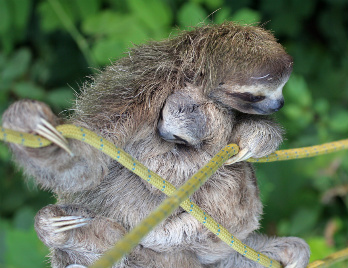 Sloth with infant hanging on a rope. Photo courtesy of Bryson Voirin. |
Mongabay: Why do you think there is such a discrepancy between hours of sleep for captive sloths and wild ones?
Bryson Voirin: Sloths in the wild have to worry about a lot of things not present in a zoo. Predators and the risk of being eaten may have a huge affect on how animals sleep. One of the projects we are working on now is looking at sloth populations with varying levels of natural predators. Wild sloths have to search out food, whereas sloths in a zoo are fed in a feeding dish. It could also be that sloths (and many animals) are bored in captivity. They are out of their natural element, and their surrounding biodiversity is not there to change their behavior, be it predation, noise, etc.
Mongabay: How do you think this study reflects on research of sleep patterns for animals in captivity?
Bryson Voirin: It shows that we need to reexamine some of the previous conclusions we have drawn on sleep based on wild animals put in a cage. If the amount of time a sloth sleeps in captivity is double what it would naturally sleep, who knows what the differences are for other animals. Sleep studies have been done in hundreds of captive animals. As we start to do more wild based recordings, we may find that many of the older studies need to be tossed out. That’s the beauty of science: we are always learning new things.
Mongabay: In order to conduct the research you had to capture sloths in the wild and tag them. Is the tree-dwelling mammal as cuddly as it looks?
 Carrying the sloth. Photo courtesy of Bryson Voirin. |
Bryson Voirin: Not at all. In photos they look a lot like a teddy bear, but in reality they have sharp claws that can do some serious damage. They can move quick when they want to, and they are not defenseless. People always laugh when I tell them I have scars all over my arms from sloths, but it’s true. They can definitely hurt you.
Mongabay: By tracking sloths, you recorded the first time a sloth has ever been killed by an owl. Can you tell us about this?
Bryson Voirin: We had a mother three-toed sloth that was being monitored by our automated telemetry system. One night, it was descending a tree, and suddenly disappeared off the screen and flatlined. In the morning, we noticed this when we checked the screens, and rushed out to find the animal. We got there fast enough to recover the carcass, and do a necropsy. We found paired claw wounds all over the neck and arms, and the animal had been eviscerated. This is typical of many avian predators, especially owls preying on larger animals. The claw wounds were from a zygodactyl bird, meaning there were two toes on each side for the claw. The only birds in Panama with that pattern are owls and ospreys. Near where we found the sloth we also found a spectacled owl perch. Thus, based on evidence from the carcass, we determined that a large spectacled owl had killed the sloth. What’s really amazing is that we found the dead sloth so fast. In the tropics, dead bodies disappear really fast, so we rarely would find a dead animal in good enough condition to examine. But because we use a constant monitoring system to track our animals, we know the minute the animal died, so we can rush into the field and find it.
Mongabay: What can you tell us about the relationship between algae and sloths?
Bryson Voirin: All species of sloths are know to host algae in their fur. Their hair has special grooves running through them where the algae live. Some people think there is a mutualistic relationship going on where the sloth either absorbs nutrients through their fur or they gain a camouflage tint to their body, and the algae are rewarded with a safe home. While it is possible, I think that sloths have adapted special hair to quickly dry when wet. These drainage grooves are also a perfect niche for tiny algae to thrive. The algae probably is just living in the hair, with no consequence, positive or negative, to the sloth.
Mongabay: Are there any species of sloth that are endangered? If so what are the threats?
Bryson Voirin: Maned three-toed sloths and pygmy three-toed sloths are both critically endangered. Both of these species are threatened by habitat destruction. The maned sloths live in the coastal rainforest of Brazil, and the pygmy sloths are only found on one island off the coast of Panama. I have worked quite a lot on the pygmy sloths on the island of Escudo de Veraguas, and there are certainly not too many of them in existence. It’s thought that the total population is less than 100 sloths.
Mongabay: Sloths spend almost their entire lives in the canopy, what other animals are important to the canopy?
 Sloth and infant. Photo courtesy of Bryson Voirin. |
Bryson Voirin: Lots of animals are important to the rainforest canopies of the world. Some animals, like certain monkeys, are called keystone species. There species are critical for sustaining the habitat, either by being a food source or providing some ecosystem service. Monkeys are crucial seed dispersers in many forests, and they are responsible for much of the plant diversity. Even tiny organisms are vital to habitats. Mosquitoes are a food source for many species around the globe. Without them, bats and many other species would die out.
Mongabay: Your research on sloths utilizes a unique talent of yours: tree climbing. Can you tell us what it is like pursuing a sloth in the rainforest canopy—a place most people never see, let alone climb in?
Bryson Voirin: Although they are called “sloths”, catching one of these animals is pretty nerve racking and difficult. The first thing you have to do is find one of them, which can take weeks. When we are looking in old-growth rainforest by foot, we average one sloth per week. Once we spot one, I then have to climb up and catch it. I use an 8 foot slingshot to fire a line over the tree, hoist a climbing rope, and use mechanical ascenders and a climbing harness to get nearer to the sloth. The sloth knows I am coming, so they usually start to run away. If they are 100 feet in the air, by the time I climb up to them, they could be several hundred feet away, crawling on twigs I cannot climb. So before I start to climb, we set up additional ropes that I can climb depending on which direction it moves. The canopy is like a highway for these animals, and I have to anticipate which route they will take. Once I am finally within about 10 feet of the sloth, I use a large snare pole to catch them by the arm and bring them to me. Once I have the sloth, the two of us rappel down the rope and out of the withing tree to the ground. It sounds pretty easy, but this process can take hours. Sometimes just setting a rope in the tree can take half a day, because I need to be certain I am over a large enough branch to support me. Safety is always my number one concern, because at these heights, a fall can be fatal.
TREE-CLIMBING
Mongabay: How did you become interested in tree-climbing?
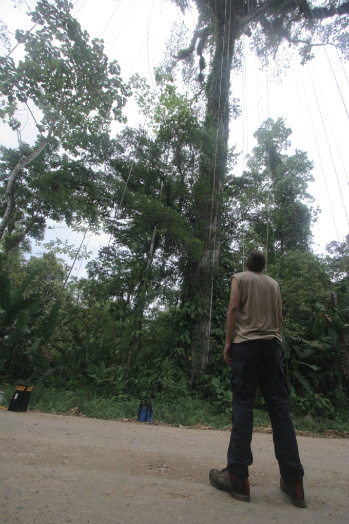 Setting up tree-climbing equipment. Photo courtesy of Bryson Voirin. |
Bryson Voirin: Since I was a kid, I was always a climber. I used to climb on my roof all the time, scaring my mom half to death. I grew up climbing oak trees and sycamores behind my house free hand. In high school in Germany, I got into rock climbing. I learned all the gear for technical climbing and practiced a lot. When I moved back to Florida for college, I remembered there were no mountains around, so I started climbing trees using my rock climbing gear. As I got more involved in research projects, I realized that I could put my hobby to use. It was sort of a natural progression that I ended up working a lot in the rainforest canopies of the world.
Mongabay: What are some of hazards of climbing trees in the rainforest?
Bryson Voirin: Climbing is risky, but its all a calculated risk. The most dangerous thing is not being careful about your gear. Gear failure is very very rare, but human error happens. Tying the right knots, securing lines properly, and taking care of the climbing gear is critical. Other risks are natural ones. Tree branches break all the time in the forest, so load testing them prior to climbing is necessary. Insects are probably the most imminent danger when climbing. Bees can come out of nowhere in giant swarms and sting you hundreds of times. A lot of the climbers I know have been swarmed by bees. But if you are safe and careful, climbing can be a safe and fun thing to do.
Mongabay: You currently teach scientists how to climb in the rainforest canopy safely—is this a new trend in rainforest research? Why is it important?
Bryson Voirin: Canopy research is a relatively new thing. I work with Meg Lowman, who was one of the first scientists to climb into the canopy back in the 1980’s. Scientists are realizing now that they can easily and safely access the canopy and conduct research up there. It’s becoming somewhat of a trend to work up in the tree tops. With proper instruction, scientists can access a whole new world of biodiversity hundreds of feet up.
Mongabay: You also teach children how to climb trees. Who are better climbers: the children or the scientists?
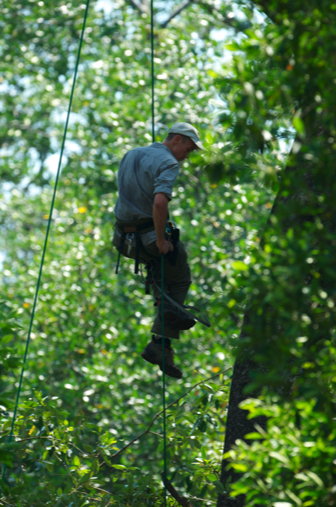 Voirin climbing into the canopy. Photo by: Cede Prudente. |
Bryson Voirin: Actually, the children are usually better. I have taught some 2nd graders who picked up on the basic principles of climbing faster than anyone else I have ever taught. They are professional climbers in about 3 minutes. A lot of adults are nervous about heights, or haven’t done any sporting activity for years, and have a lot of difficulty. Kids who play outside all day are natural born climbers.
Mongabay: You have said that instructing children on tree-climbing allows you to also teach them about science. How do the two go together?
Bryson Voirin: Just being outside gets people interested in the natural world. If you play video games all day, you are totally disconnected from nature. Going outside and climbing to the top of a big tree, kids start wondering about the outdoors. “How tall is this tree?” “How old is it?” “Where are the tallest trees in the world?” Kids are naturally inquisitive, and really connect with being outside. Nearly every kid I have taught to tree climb has asked me numerous questions about the environment and science. It sparks their interest.
Mongabay: What do you think a scientist’s role is when it comes to education and outreach?
Bryson Voirin: As a scientist, I think my biggest contribution is sharing what I discover with the public. Some scientists only ever write articles for a very specific audience, generally other scientists. While I also do this, I enjoy writing pop articles for newspapers or magazines read by people of all ages and backgrounds. Or giving talks to school children about the rainforest, or sloths, or any exciting research I am working on. I think it is my duty to connect with the general public in these ways, and share knowledge.
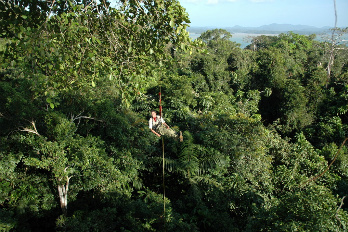 Voirin against the canopy. Photo courtesy of Bryson Voirin. |
On another note, I think it is vital for scientists to avoid being demagogues, that is trying to politicize science for an agenda. It is our job to be unbiased in our methodology, and share results that are factually based at all times. Our profession is one based on our credibility, and when psudo-science is put forth as truthful by a “scientist”, it hurts all of our credibility.
Mongabay: Do you believe scientists are active enough in these activities?
Bryson Voirin: Some are, and some are not. A lot of scientists might lack the skills to convey their message in a manner in which a general audience would understand. The best professor I have ever had once said I should be able to explain any research project I am doing to a 5 year old, regardless of how complex it is. It is a special skill to be able to engage audiences ranging in age from 5 -90 years old. I am lucky to have that skill, and I use it often.
TRACKING OTHER TROPICAL ANIMALS
Mongabay: On top of everything else you also track other tropical wildlife on BCI. Can you tell us about BCI and some of the other species you track?
 Sloth swimming. Photo courtesy of Bryson Voirin. |
Bryson Voirin: BCI stand for Barro Colorado Island. It’s an island run by the Smithsonian Institute, and is located in the middle of the Panama Canal. We have a laboratory there called ARTS (Automated radio telemetry system), which is used for continuous monitoring of radio-collared animals. We track a wide variety of animals. These include agoutis (like giant rats), coatis (like raccoons), ocelots, hawks, tamanduas (anteaters), and numerous other birds, mammals, and insects. We have even tracked bees!
Mongabay: What kind of equipment do you use to track these species? Do different species require different devices?
Bryson Voirin: For most of the species we use radio transmitters. We design custom transmitters for each animal, based on size and weight. Dragonflies need a much smaller tag than an ocelot. Each animal is targeted individually. We record the signals with 7 telemetry towers around the island that feed back the data to the lab. We can also use handheld receivers to find the animals out in the wild and visually observe them. We also have special GPS tags that are used on migratory species, especially birds. These tags record GPS locations at regular intervals and store them on a micro hard-drive. We then can download from this remotely from a plane, helicopter, or from the ground. Its very cool technology!
Mongabay: What are some of the surprising discoveries that have come out of tracking these species?
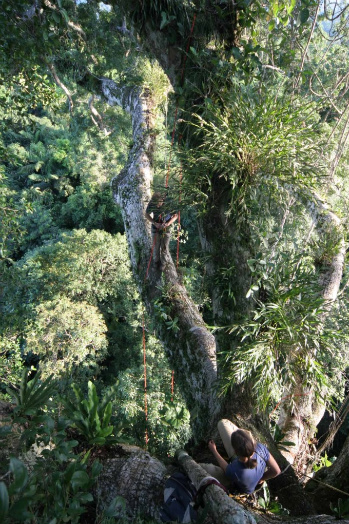 View from the canopy. Photo courtesy of Bryson Voirin. |
Bryson Voirin: Lots of cool things are discovered by tracking species. We found that dragonflies migrate. Millions of these insects migrate hundreds of miles at a time, and we had no idea that it happened at all. We found that orchid bees travel miles across the canal to certain flowers to gather pollen and create a custom perfume to impress female bees. There are so many unanswered questions when it comes to wild animals. Everyday we are finding new and exciting results.
Mongabay: What are the unique attributes of the oilbirds in Venezuela?
Bryson Voirin: The oilbirds are truly unique. They echo-locate, like bats, so they can find their way around giant caves in complete darkness. At dusk, thousands of them gather at the opening of the cave and fly out in a giant swarm. They fly hundreds of miles, eating various fruits along the way. During the day, they sit in the caves and regurgitate the seeds. It’s impressive walking through these huge caves and seeing massive piles of seeds under the nesting ledges of the oilbirds. Using GOS loggers, we actually discovered that these birds stay out for 3 days at a time, regurgitating seeds under trees in the forest during the day. Everyone always thought these birds come back to the cave every night, but we showed this not to be true.
Mongabay: Many of the species you track are threatened, what are the greatest threats to tropical wildlife?
Bryson Voirin: The greatest threat to tropical wildlife is habitat destruction and hunting. The tropical rainforest are teeming with wildlife, including people. The villagers around these forests need a way to earn a living, so often they harvest animals and plants from the forest. It’s a difficult situation, because the animals need the forest to survive, and the people there need an income to survive. Luckily, many governments are working to strike a balance between the two needs.
Mongabay: What can the general public do to help these species?
Bryson Voirin: The best thing people can do is educate themselves. Learn about wildlife, and what is really threatening them. Understanding both sides of the issues is important. A lot of concerned people vow to save species, but fail to think critically about the implications of their actions. I have seen the effects of unintended consequences on behalf of conservation in the tropics. If we are going to save species, we have to involve local people.
Mongabay: Given that you have had a very successful career so far—and you’re only twenty-four—what advice would you have for an undergraduate who is interested in going to graduate school to work in the tropics?
Mongabay: Any future plans you would like to share with us?Bryson Voirin: Get involved! While spending time in a classroom or library is an important part of education, so is being exposed to fieldwork. Volunteer as a field assistant, work with a professor on a project, or anything you can do to get involved. Being in college is a great opportunity to meet scientists doing very interesting work. Approach your professors about how you ca get involved. Getting good grades are important, but to really stand out and get opportunities all you have to do is ask.
Bryson Voirin: For the moment, I am working on my PhD with the Max Planck. I have been working lately as a scientific consultant and guest on several TV programs. It’s my hope that one day I can host my own science show, bringing the awesome world of science home to people around the world.

